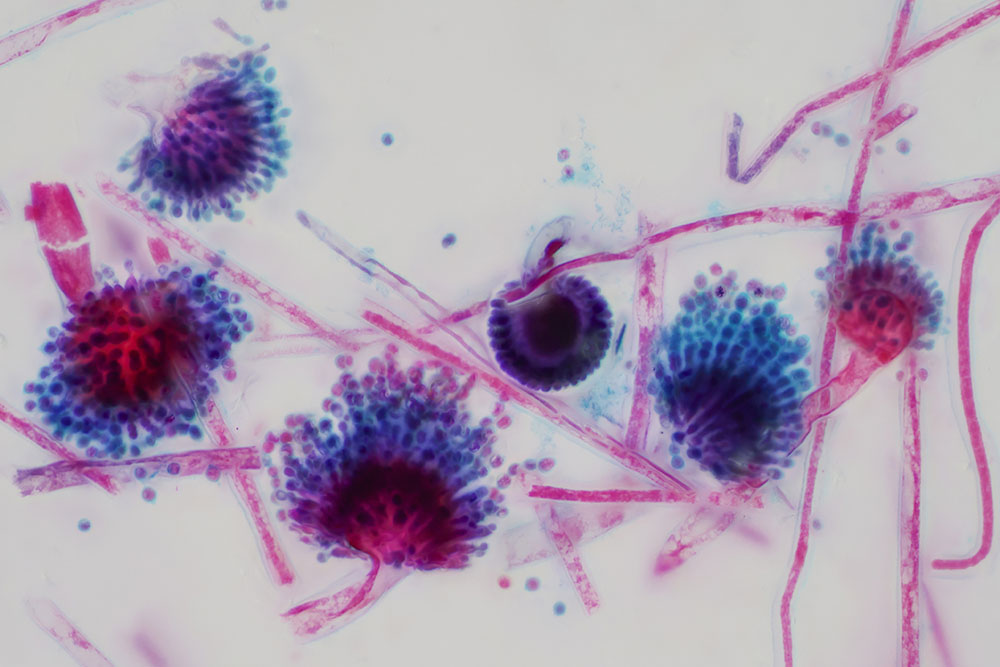What Is Red Mould?
 CONTENTS
CONTENTS
- What is red mould?
- Why does mould turn red?
- Where does red mould usually grow?
- Is red mould more dangerous?
- What to do when you see any signs of mould
- Get in touch
Most people expect mould to be dark, earthy colours like black, brown, and green, but it can actually come in a range of shades, including purple and red. Should you fail to different types of mould in its early stages and you could soon be dealing with a big problem.
Here at ICE Cleaning, we offer fast and effective mould remediation services. Our Dewpoint-accredited technicians can also diagnose the root cause of mould and advise on how to stop it from returning. They are available nationwide, 365 days a year.
Read on to learn more about red mould and what causes it.
What is red mould?
Red mould is a fungus that you will see growing both inside and outside of your home. Like all kinds of mould, it thrives in warm, moist conditions and can be found on surfaces like fabrics, drywall, and food.
Mould can first appear in a variety of colours and then change over time. Black mould could turn into red mould, for instance, and then change back.
Why does mould turn red?
Throughout a mould's life cycle, it will experience changes in the environment such as a shift in humidity, an introduction of natural light, or a change in a food source. These factors could cause mould to transition into different colours like black, green, or white.
Red mould is not its own species, and all moulds can turn red over time. The most common form of red mould you may encounter is Aspergillus which is a type of fungus that can grow in bathrooms and kitchens. Neurospora is another kind of mould that can appear red and you will normally find it on food items.
A red colour may also indicate that mould spores have been released and become airborne. This can happen if you have left mould for a long time or the atmosphere in your home has changed.
Where does red mould usually grow?
You are more likely to see red mould growing on surfaces that become wet and warm, like tilework around the shower, sink, or bath. You could also see it growing on decomposing vegetables or stale foods containing yeast or carbohydrates. Red mould can grow on building materials if they have been affected by water or a leak, too.
When mould begins growing on these items, you must throw them out due to the damage mould can cause to structural surfaces. Red mould will eventually extend beyond these humid areas and into living spaces like your bedroom through the air, making it harder to remove.
Is red mould more dangerous?
Because red mould is just a colour of fungus rather than its own species, it poses similar risks to white, green, and black mould. It is not more or less hazardous, but mould itself could still affect vulnerable people, including:
- Immunocompromised individuals
- Elderly people
- Babies
- Young children
Neurospora may grow on your food if it has reached your cupboards. Ingesting mould can pose a toxic risk, especially if you are sensitive or allergic to mould, so dispose of any food you suspect might have red mould on it.
By touching, breathing, or ingesting any form of mould, you could become vulnerable to the effects and develop symptoms such as:
- Sneezing
- Skin and eye irritation
- Chest tightness
- Fatigue
- Dizziness
- Headache
- Shortness of breath
- Coughing
What to do when you see any signs of mould
When you see mould in your home, you may believe you can clean it yourself with a DIY solution. However, you could put your health at risk and probably will not remove all of the mould effectively.
Instead, you must contact a mould removal company that specialises in cleaning and decontaminating your home as soon as possible. In the meantime, you could help prevent growth by ventilating your home and investing in a dehumidifier.
If you suspect that your home may be at risk of mould growth, you can do the following to prevent it:
- Keep humidity levels low
- Ventilate your home often
- Maintain your pipework
- Clean your home regularly
- Dispose of fabrics infected by mould
- Buy a dehumidifier
- Insulate your home
- Contact mould removal companies to do a swab test
Get in touch
At ICE Cleaning, each mould removal service comes with a lifetime guarantee* to keep your property mould-free. Our expert technicians also offer additional drying and odour removal services to thoroughly clean and restore your home.
We will be on-site in a matter of hours in an emergency, and you can get a free, no-obligation quote today when you contact us at 0208 066 0360 or enquiries@icecleaning.co.uk.
*subject to advisories

Speak with me today,
I’m here to help
By asking you a few questions either via phone or email I can immediately provide a realistic estimation of the cost.
You’re in good company. We’ve cleaned for the following commercial clients… View all

Why choose us?
- Cater to a wide variety of cleaning situations
- Nationwide coverage, available 24/7
- Cater to commercial and domestic clients
- Free survey provided prior to quotation
- Emergency response team
- Offer a bespoke service designed to suit all your needs
- All technicians hold professional health and safety qualifications, including BICSc, IOSH, Dewpoint Professional & Safe Contractor
We’re fully accredited
We place best practise, professional expertise and health and safety at the core of our business. We’re fully compliant with all legal obligations. You can view a list of our accreditations below, or visit our Health & Safety page for more information.











-RGB-small.1707319151.jpg)




















